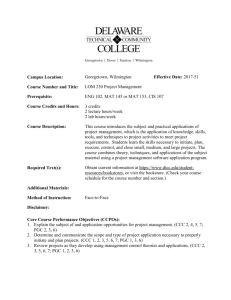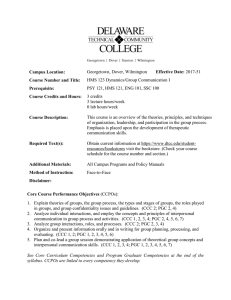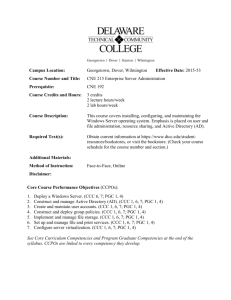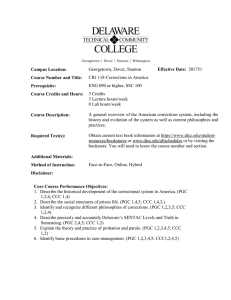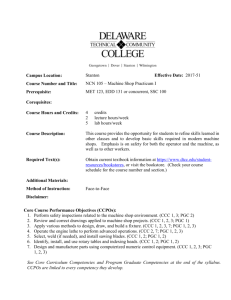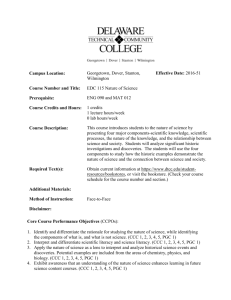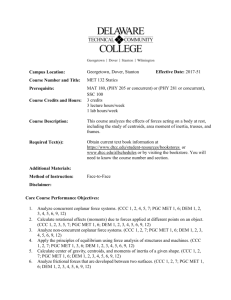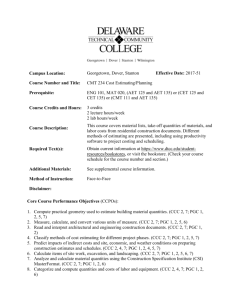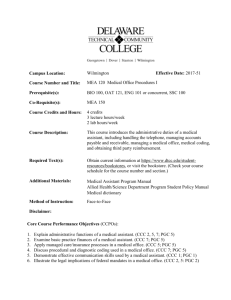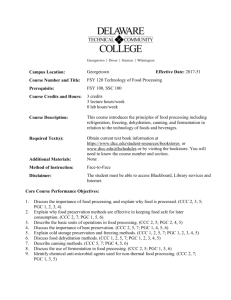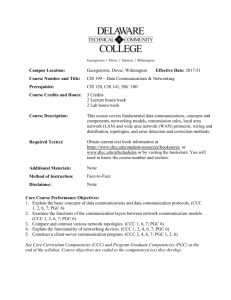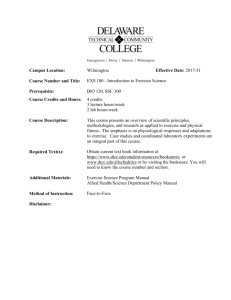IET 209 201552 - E
advertisement
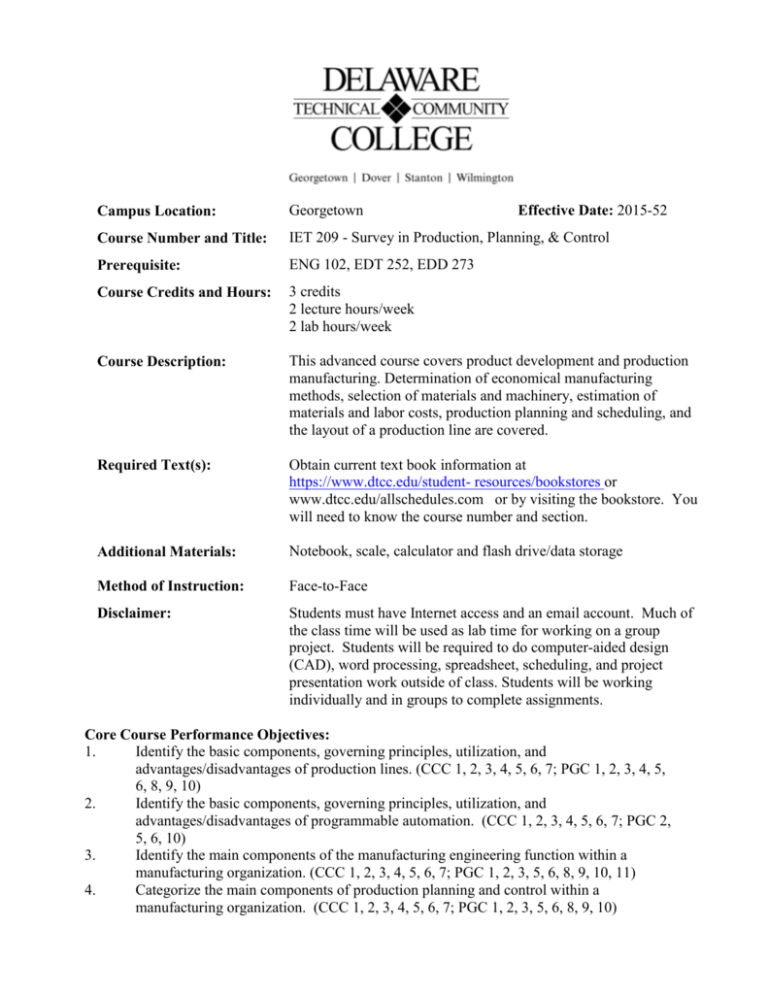
Campus Location: Georgetown Effective Date: 2015-52 Course Number and Title: IET 209 - Survey in Production, Planning, & Control Prerequisite: ENG 102, EDT 252, EDD 273 Course Credits and Hours: 3 credits 2 lecture hours/week 2 lab hours/week Course Description: This advanced course covers product development and production manufacturing. Determination of economical manufacturing methods, selection of materials and machinery, estimation of materials and labor costs, production planning and scheduling, and the layout of a production line are covered. Required Text(s): Obtain current text book information at https://www.dtcc.edu/student- resources/bookstores or www.dtcc.edu/allschedules.com or by visiting the bookstore. You will need to know the course number and section. Additional Materials: Notebook, scale, calculator and flash drive/data storage Method of Instruction: Face-to-Face Disclaimer: Students must have Internet access and an email account. Much of the class time will be used as lab time for working on a group project. Students will be required to do computer-aided design (CAD), word processing, spreadsheet, scheduling, and project presentation work outside of class. Students will be working individually and in groups to complete assignments. Core Course Performance Objectives: 1. Identify the basic components, governing principles, utilization, and advantages/disadvantages of production lines. (CCC 1, 2, 3, 4, 5, 6, 7; PGC 1, 2, 3, 4, 5, 6, 8, 9, 10) 2. Identify the basic components, governing principles, utilization, and advantages/disadvantages of programmable automation. (CCC 1, 2, 3, 4, 5, 6, 7; PGC 2, 5, 6, 10) 3. Identify the main components of the manufacturing engineering function within a manufacturing organization. (CCC 1, 2, 3, 4, 5, 6, 7; PGC 1, 2, 3, 5, 6, 8, 9, 10, 11) 4. Categorize the main components of production planning and control within a manufacturing organization. (CCC 1, 2, 3, 4, 5, 6, 7; PGC 1, 2, 3, 5, 6, 8, 9, 10) 5. Work as a team member to develop a design and manufacturing process for a hypothetical mechanical product. (CCC 1, 2, 3, 4, 5, 6, 7; PGC 1, 2, 3, 4, 5, 6, 7, 8, 9, 10, 11) See Core Curriculum Competencies (CCC) and Program Graduate Competencies (PGC) at the end of the syllabus. Course objectives are coded to the competency(cies) they develop. Measurable Performance Objectives: Upon completion of this course, the student will: 1. Identify the basic components, governing principles, utilization, and advantages/disadvantages of production lines. 1.1 1.2 1.3 1.4 1.5 2. Identify the basic components, governing principles, utilization, and advantages/disadvantages of programmable automation. 2.1 2.2 2.3 2.4 2.5 3. Identify the main components of a manual production line. Identify the main components of an automated production line. Determine the minimum number of workstations required for a production line for a specific product. Calculate line balance for a production line. Analyze the theoretical efficiency of a production line. Describe the main components of a numerical control (NC) system. Perform basic positioning, precision, and accuracy calculations for an NC system. Explain the differences, similarities, advantages, and disadvantages between open-loop and closed-loop NC systems. Identify the components of an industrial robotic system. Describe the control systems used for industrial robotic systems. Identify the main components of the manufacturing engineering function within a manufacturing organization. 3.1 3.2 3.3 3.4 3.5 3.6 3.7 3.8 Describe how process planning is used in the manufacturing environment. Prepare a route sheet for a hypothetical component part. Explain how designing for manufacturability can reduce product cost and reduce the time it takes to bring a new product to market. Outline the general principles and guidelines in designing for manufacturability. Outline the process of concurrent engineering and how it is applied to new product development. Describe the main types of rapid prototyping and how they are used in product development. Describe the key considerations in incorporating ergonomics in the design of manufacturing and assembly workstations. Discuss the major factors influencing the quality of manufactured goods and how they can be monitored, controlled, and continuously improved to increase quality. 4. Categorize the main components of production planning and control within a manufacturing organization. 4.1 4.2 4.3 4.4 4.5 4.6 5. Define the role of aggregate planning and master production scheduling in manufacturing. Describe the processes and techniques used in inventory control. Calculate economic order quantities for a hypothetical product. Outline the process of material requirement planning. Outline the process of workstation, machine, shop, and line capacity requirement planning. Describe how lean production is used in the manufacturing environment to reduce costs and inventory size Work as a team member to develop a design and manufacturing process for a hypothetical mechanical product. 5.1 5.2 5.3 5.4 5.5 5.6 5.7 5.8 5.9 5.10 Conduct a market review for a hypothetical mechanical product. Develop a design for a mechanical product. Prepare engineering, working, and assembly drawings. Specify materials of construction, production methods, and assembly techniques. Develop a detailed bill of materials (BOM) and a yield analysis. Generate route sheets for components and component assembly. Prepare an economy-of-scale analysis for one or more components. Design a production line, including work stations, machinery, tooling, and staffing. Prepare a cost estimate. Develop a business plan. Evaluation Criteria/Policies: Students will demonstrate proficiency on all Core Course Performance Objectives at least to the 75 percent level to successfully complete the course. The grade will be determined using the College Grading System: 92 – 100 = 83 – 91 = 75 – 82 = 0 – 74 = A B C F Students should refer to the Student Handbook for information on Academic Standing Policy, Academic Honesty Policy, Student Rights and Responsibilities, and other policies relevant to their academic progress. Core Curriculum Competencies: (The competencies every graduate will develop) 1. Communicate clearly and effectively both orally and in writing. 2. Demonstrate effective problem solving and reasoning skills. 3. Work effectively in groups of people from diverse backgrounds. 4. Demonstrate ethical and professional understanding and conduct. 5. 6. 7. Apply appropriate information literacy skills to locate, evaluate, and use information effectively. Use computer technology appropriate to the field. Use scientific and mathematical reasoning appropriate to the technology. Program Graduate Competencies: (The competencies every graduate will develop specific to his/her major.) 1. Apply the knowledge, techniques, skills, and modern tools of the discipline to narrowly defined engineering technology activities. 2. Apply a knowledge of mathematics, science, engineering, and technology to engineering technology problems that require limited application of principles but extensive practical knowledge. 3. Conduct standard tests and measurements, and to conduct, analyze, and interpret experiments. 4. Function effectively as a member of a technical team. 5. Identify, analyze, and solve narrowly defined engineering technology problems. 6. Apply written, oral, and graphical communication in both technical and nontechnical environments; and identify and use appropriate technical literature. 7. Recognize the need for and an ability to engage in self-directed continuing professional development. 8. Integrate a commitment to address professional and ethical responsibilities, including a respect for diversity. 9. Demonstrate a commitment to quality, timeliness, and continuous improvement. 10. Demonstrate knowledge and technical competency in engineering materials, applied mechanics, and manufacturing methods. 11. Demonstrate knowledge and in-depth technical competency in applied drafting practice emphasizing mechanical components and systems, as well as fundamentals of descriptive geometry, orthographic projection, sectioning, tolerancing and dimensioning, and computer aided drafting and design. 12. Demonstrate knowledge and technical competency in the in-depth application of physics having emphasis in mechanical components and design.
